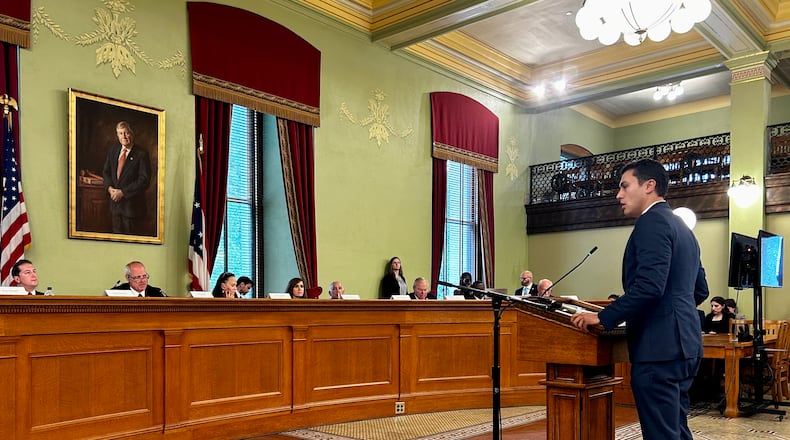Much of this week’s debate centered around a map “unduly” favoring one party over the other.
Democrats argued that the state’s current maps, which produced a 10-to-5 congressional advantage for Republicans in the last two election cycles, disproportionately favor the GOP. They say Ohioans, on average, have split their vote 55%-to-45% in statewide, partisan elections over the past decade.
“This is an eight-to-seven state, and we should have congressional maps that reflect that,” said House Minority Leader Dani Isaacsohn, D-Cincinnati, who had the first at-bat of the redistricting season. “Because, when we have competitive districts, voters get to choose their candidates. They get to have people vie for their vote, and we end up with policies that reflect the will of where most voters are.”
Republicans, meanwhile, suggested that Democrats’ proposal works backwards, by aiming to draw the congressional boundary lines in a specific way as to reduce the minority party’s current disadvantage.
“It really sounds like the overriding goal of your map is just to engineer, artificially, more seats that Democrats can win,” Rep. Brian Stewart, R-Ashville, said to Isaacsohn. “How is that not the textbook definition of gerrymandering?”
“It gets into, what do we mean by ‘gerrymandering,’” Isaacsohn said. “What I mean, when I say it, is that it is the production of district maps that do not accurately and fairly represent the viewpoints of the people that they are trying to represent.”
Quibbles over what can actually be defined as gerrymandering continued throughout the hearing.
So far, the Democrats’ proposal is the only one introduced to the legislature. The initial deadline for the state legislature to approve a bipartisan map is at the end of the month.
Credit: Provided
Credit: Provided
While their proposed map would create a more even district balance in the state, three of the proposed Democratic-leaning districts are projected to be extremely competitive — within three percentage points — based on voting data.
The most competitive Republican district, under the Democratic proposal, would be centered in Montgomery County. Projections give the district a 54.7% to 45.3% Republican-to-Democrat ratio.
In his testimony, Sen. Willis Blackshear, D-Dayton, expressed frustration with Republicans’ lack of movement on the redistricting front. The hearing, held Sept. 22, comes just more than a week from the legislature’s end-of-the-month deadline. If the legislature fails to meet the deadline, as expected, the responsibility will kick over to the Ohio Redistricting Commission, a seven-member, GOP-controlled board that has another month to produce a bipartisan map.
Blackshear said this year’s lackadaisical approach to redistricting gave him “deja vu” of the last go around.
“It’s absolutely critical that we not allow people to delay or make a mockery of this process as it has been done in the past,” he said. “These hearings are critical to gathering public input, and I commend every single person in this room for participating in this process.”
Dozens of Ohioans submitted public testimony to the committee, largely encouraging the legislature to pass “fair maps.”
Aileen Maddox, testifying on behalf of her role in the Black Women’s Health Initiative of Dayton, said the current congressional maps have produced “politicians who don’t answer the phone because they don’t need to. Their seats are safe, not because we put them there, but because the lines were drawn to keep them there.”
“When districts are gerrymandered, our voices are excluded from the process,” she testified. “The decisions made by people who don’t understand the healthcare needs of the district are affecting whether we live or die. It’s that real.”
For more stories like this, sign up for our Ohio Politics newsletter. It’s free, curated, and delivered straight to your inbox every Thursday evening.
Avery Kreemer can be reached at 614-981-1422, on X, via email, or you can drop him a comment/tip with the survey below.
About the Author


